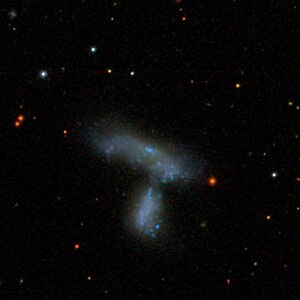NGC 4809
| Galaxy NGC 4809 |
|
|---|---|

|
|
| SDSS recording | |
| AladinLite | |
| Constellation | Virgin |
|
Position equinox : J2000.0 , epoch : J2000.0 |
|
| Right ascension | 12 h 54 m 51.0 s |
| declination | + 02 ° 39 ′ 15 ″ |
| Appearance | |
| Morphological type | In the pec / HII |
| Brightness (visual) | 14.0 mag |
| Brightness (B-band) | 14.6 mag |
| Angular expansion | 1.7 x 0.7 |
| Position angle | 68 ° |
| Surface brightness | 14.0 mag / arcmin² |
| Physical data | |
| Affiliation | LGG 292 |
| Redshift | 0.003052 ± 0.000020 |
| Radial velocity | (915 ± 6) km / s |
|
Stroke distance v rad / H 0 |
(38 ± 3) x 10 6 ly (11.6 ± 0.8) Mpc |
| history | |
| discovery | RJ Mitchell |
| Discovery date | April 18, 1855 |
| Catalog names | |
| NGC 4809 • UGC 8034 • PGC 43969 • CGCG 043-062 • MCG + 01-33-022 • IRAS 12523 + 0255 • Arp 277A • VV 313a • GC 3309 • | |
NGC 4809 is a 14.0 likes bright irregular galaxy with extensive star formation from Hubble type in pec in the constellation Virgo . It is estimated to be 38 million light-years from the Milky Way and, together with NGC 4810, forms a gravitational double galaxy (Arp 277) . Halton Arp organized his catalog of unusual galaxies into groups according to purely morphological criteria. This pair of galaxies belongs to the class of interacting double galaxies .
In 2011, the supernova SN 2011jm was observed here.
The object was discovered on April 18, 1855 by RJ Mitchell , an assistant to William Parsons .
Web links
- NGC 4809. SIMBAD, accessed February 14, 2015 .
- NGC 4809. DSO Browser, accessed February 14, 2015 .
- Auke Slotegraaf: NGC 4809. Deep Sky Observer's Companion, accessed February 14, 2015 .
- ARP ATLAS OF PECULIAR GALAXIES
- Seligman Arp
literature
- Jeff Kanipe and Dennis Webb: The Arp Atlas of Peculiar Galaxies - A Chronicle and Observer's Guide , Richmond 2006, ISBN 978-0-943396-76-7
